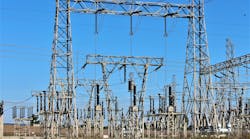In 1991, Hawaiian Electric Co. (HECO) initiated the design of a 138-kV line to increase system reliability by providing an alternate corridor for power delivery on the island of Oahu. The 15.4 mile (24.7 km), double-circuit line was intended to deliver power from the Kahe Power Plant on the western side of the island to the major load center on the eastern side. Because of high wind loads, proper sizing of structural members was critical. The ASCE Manuals and Reports on Engineering Practice No. 74 provided a methodology in the development of structure design wind loads. At the time, HECO also considered using a low-drag conductor. Although no test data were available, the physical properties of the conductor supported the idea that its design would, indeed, result in reduced drag characteristics at a price only slightly higher than regular stranded conductor of the same size.
In applying the appropriate equations to determine probable wind pressures on the horizontal projected areas of both structure and conductors, HECO had to consider factors involving: -Terrain. -Base design wind speed, mph. -Gust response. -Force (drag) coefficient.
The two key variables were the base design wind speed and the terrain factor. Although the ASCE manual recommended the use of an 80-mph base wind speed for the Hawaiian Islands, recorded wind data from Hurricanes Iwa (1982) and Iniki (1992) convinced the design team to increase the wind speed parameter to 100 mph (160 km per hour).
In determining the proper terrain factor, HECO examined the location and terrain features of the line and decided the line should be close to the coast, near Pearl Harbor. Much of this area was devoted to the cultivation of sugar cane. These parameters were covered by "exposure category C" having a value of 1.181. In addition, since the true drag characteristics of the conductor were not known, a value of 1.12 was estimated for the drag coefficient. Applying suitable values to the equation that had been derived for this application (P = F/A = 0.00256(ZvV)2GCf), where: -Zv=1.181 -V=100 mph -G=1.010 -Cf=1.12
A design wind pressure was determined to be 41 psf on the conductors. This value was used in the design and fabrication of the steel poles.
The Line Because of public concern about the aesthetics of the line, HECO decided on guidelines that included: -Using self-supported tubular steel monopoles -Reducing the height of poles as much as possible -Using span lengths between 400 ft (122 m) and 700 ft (213 m). -Restricting ground line diameters of the poles to 36 inches for tangent poles and to 54 inches (137 cm) for deadend poles.
Construction of the project commenced in July 1994 and was completed in August 1995.
Conductor Selection HECO traditionally has used all-aluminum conductors (AAC) for its lines in order to mitigate the corrosive effects of the ocean's salt air. With the design restrictions that had been imposed relative to pole height and span lengths, the AAC could not provide the required ampacity since its sags would have been excessive. At this point, HECO selected the low-drag conductor since it used a steel core that would reduce sag and, thus, meet the clearance requirements of the line. The conductor, supplied by ACPC, Inc., was designated as Athabaska/AW/TW/LWD ACSR 1949.6 kcmil. It is rated at 2000A at 125oC and is dimensionally equal to the 1590 kcmil 45/7 ACSR Lapwing.
The characteristics of the Athabaska conductor are: -Stranding: 42/7 -Diameter: 1.504 inches -Cross sectional area: 1.6377 sq inches -Weight: 2.143 lb/ft -Rated strength: 51,900 lb
While the stress/strain characteristics of the conductor are similar to other ACSR, its physical characteristics are unique. The nomenclature of the conductor provides some indication of this uniqueness. Athabaska is the name of the conductor. AW indicates that the steel core strands are aluminum-clad steel to improve corrosion resistance. TW indicates that the aluminum strands over the core are trapezoidal in shape, which reduces the area of voids within the conductor and gives the conductor a near cylindrical shape. LWD indicates that the conductor is a low drag conductor, which is achieved by placing dimples, about 3/8-inch apart on the surface of each outer strand.
Conductor Drag Theory Conductor drag is dependent on the characteristics of the airflow around the conductor. The airflow can be divided into three regimes, which are subcritical flow, supercritical flow and the transition between subcritical and supercritical. Due to the varying flow characteristics of these regimes the conductor drag values can differ widely. When analyzing conductor behavior under wind conditions both the Reynold's number and the drag coefficient of the conductor are important parameters. In the low Reynold's number range, for subcritical flow, the upstream flow before the separation point is laminar and the transition to turbulent flow occurs in the wake. The wake becomes increasingly turbulent as the Reynold's number increases and the boundary separation points move downstream. After the critical Reynold's number is passed, the wake narrows significantly and the vortex shedding becomes much more random. The narrowing of the wake produces a drop in drag coefficient. Beyond this transition, the vortex shedding returns to some regularity, and the drag coefficient increases to a stable value at the high Reynold's number, at supercritical flow.
Since the drag coefficient is directly related to the location of the boundary separation points and the width of the wake zone with respect to the conductor diameter, the drag coefficient for low Reynold's numbers at subcritical flow will be greater than that for high Reynold's numbers at supercritical flow. In the design of transmission structures, the engineer must design for the maximum conductor force that will be caused by the wind. Despite the fact that the conductor drag will be less at high wind velocities,the high velocity parameter, which is a squared quantity, overcomes this benefit to render high wind conditions as the governing condition to be considered when designing structures.
Wind Tunnel Tests Subsequent to the completion of the Waiau-CIP 138-kV line, the conductor was tested at the J. A. Jones Power Delivery facility in Haslet, Texas, U.S., to define the performance of the conductor under high wind speeds.
In theory, the performance of the low drag conductor will be optimized under high wind conditions, when wind flow characteristics are in the supercritical region. Under these conditions, dimpling on the surface of a spherical body will cause the airflow boundary separation to move downstream on the conductor surface, significantly narrowing the area in which the wake is generated. Since drag is directly proportional to the amount of wake generated, the dimpled surface would be expected to generate less drag than a smooth surface.
For the test, a 69-inch length of conductor was suspended on a two-point balance system in a 6 ft by 9 ft wind tunnel test section. The conductor was subjected to 22 incremental steps of wind speed between 15 and 175 mph. A comparison with similar tests made by ALCOA on a smooth cylinder and on the 1780 kcmil ACSR Chukar with an OD of 1.602 inches, demonstrated that the dimpled Athabaska conductor displayed a significantly improved drag characteristic. Compared to the ASCE recommendation, the drag of the Athabaska is about 11% to 30% lower. Upon analyzing the test data further, HECO found that its low-drag conductor should have a drag coefficient of 0.80 compared with the 1.12 value that was used in the line's design.
Low Drag Conductor Advantages The primary advantage of using a low drag conductor is to reduce loads on support hardware and structures. The application of this advantage can be manifested in at least three ways: -A utility may wish to upgrade an existing line by reconductoring with a larger conductor. By using the low-drag design, the larger conductor may not impose additional significant wind loading onto the structure, minimizing any structural upgrades for the reconductoring process. -A utility that assumes the standard drag coefficient of 1.0 will realize a large margin of safety if it uses a low drag conductor. As an example, in the design of the Waiau-CIP 138-kV lines, HECO used a value of 1.12 to obtain a wind pressure of 41 psf. If the 41 psf design pressure and the drag coefficient value of 0.80 for a 100 mph base wind is used, the calculated design wind speed is 119 mph. By using the 100 mph figure, an added factor of safety has been incorporated into the line's design. This additional factor of safety is important to HECO, since the Waiau-TIP line is the only major transmission line on Oahu designed with the benefit of actual hurricane wind data. Its survivability under hurricane conditions will directly impact the recovery efforts on Oahu in the aftermath of such an event. -A utility that designs for a specific base wind speed will have lower structural loads using the low drag conductor. Assuming a base wind speed range between 70 and 110 mph, the reduction of the conductor wind pressure loads can range from 28% to 19%. The poles which would be most affected by this reduction will be the tangent and small-angle poles for which the wind pressure loads make up the majority of the pole design. A reduction in the design loads will reduce the weights and subsequent cost for these poles.
Although the application of low-drag conductors can be a financial benefit to a utility, care must be exercised in their selection, since drag is highly dependent on the conductor diameter, stranding and dimple pattern. Anyone contemplating its use might consider tunnel testing for a specific conductor prior to its specification for a given job.
Clinton Y. W. Char is a civil/structural engineer with HECO. He has more than 18 years experience in the field, the last six of which have been in transmission line design. He has the BS degree from the University of Hawaii at Manoa and the MS degree from Purdue. He is a licensed professional engineer in Hawaii.
Glenn A. Davidson is T&D project manager for Stone & Webster and has more than 30 years of experience in transmission line design. He has BS and MS degrees from New Jersey Institute of Technology. He has been responsible for the design of transmission lines from 34.5 kV through 500 kV. He is a senior member of IEEE and chairs the Working Group on Overall Line Design.

